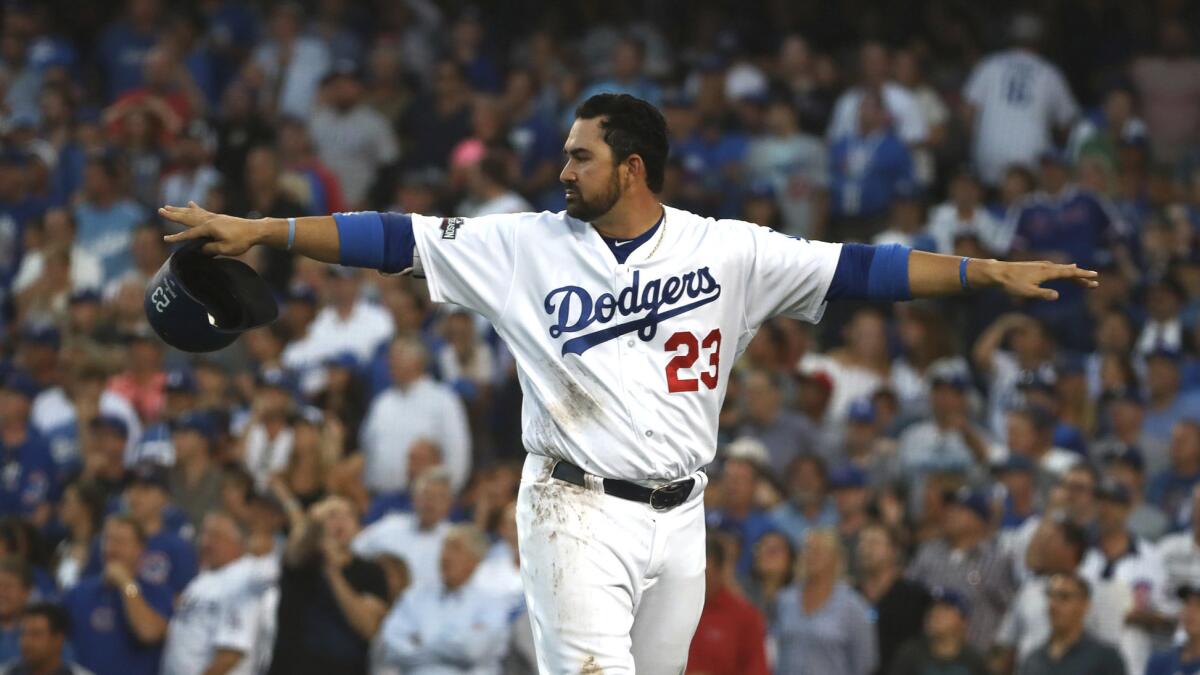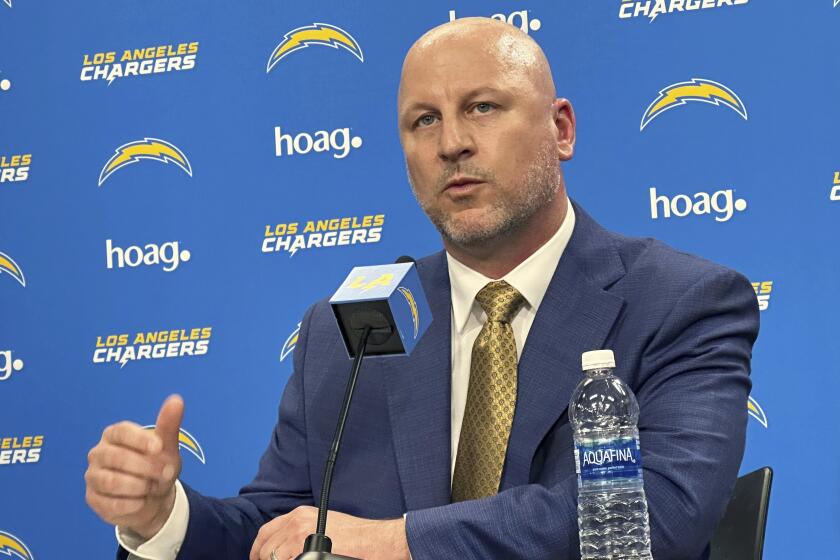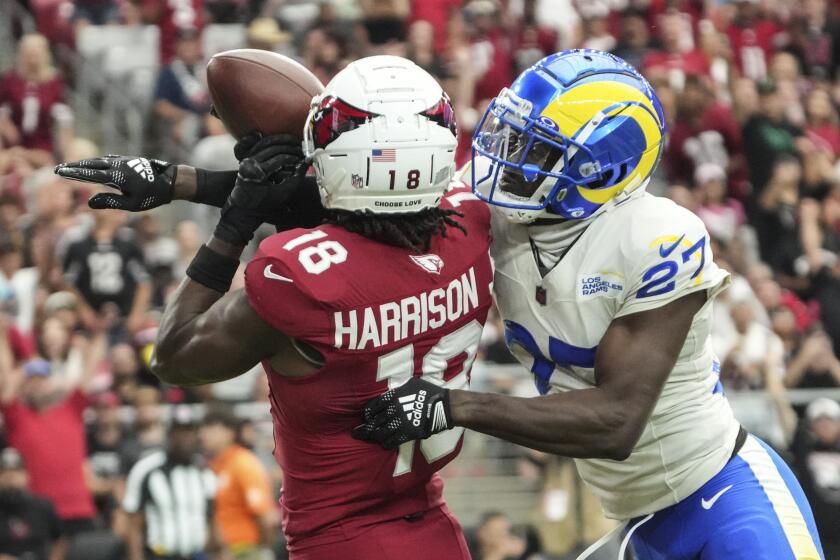Column: Against Cubs in Game 6, Adrian Gonzalez readies for another ‘chess game’

Dodgers runner Adrian Gonzalez is convinced he’s safe after he is tagged out at home by Cubs catcher Willson Contreras in the second inning of Game 4 on Oct. 19.
Reporting from Chicago — Adrian Gonzalez should have felt worn down. At 34 years old he had played in more than 160 games this year, many with excruciating pain in his neck or back.
Except there he was, standing in the middle of an otherwise empty locker room at Wrigley Field, smiling and laughing as he pointed here and waved there. Later, he illustrated an argument by throwing his arms out along his usual swing path.
“I love it,” he said.
There was something charming about a 13-year veteran sharing his thoughts on hitting with child-like enthusiasm.
The scene took place more than a week ago, before the Dodgers and Chicago Cubs opened the National League Championship Series. Since then, the stakes have been raised considerably, the Dodgers heading into Game 6 knowing that a loss will end their season.
Gonzalez’s objective remains the same. The five-time All-Star has to figure out how the Cubs will pitch to him and what he will do in response.
“It’s like a chess game,” he said.
That game will have him focused Saturday on Cubs starter Kyle Hendricks, a crafty right-hander nicknamed “The Professor.”
They met earlier in the series, with Gonzalez hitting a second-inning home run that accounted for the only run in the Dodgers’ 1-0 victory in Game 2.
The pitch he sent into the left-field stands was a fastball — a pitch he was expecting.
“First at-bat, nobody on base, I wanted to be aggressive,” Gonzalez said. “First time through the order, he attacked us with fastballs early, trying to establish his fastball, knowing that he was going to go to his changeup later in the game. So I just wanted to get a fastball and try to elevate it.”
Hendricks probably won’t make the same mistake Saturday. Gonzalez will have to anticipate how the Dartmouth-educated pitcher will adjust.
Gonzalez is particularly adept at this mental exercise, which explains why he has been one of baseball’s most consistent run producers over the last decade. He has played in four postseason series for the Dodgers over the last four years and has homered in every one of them. He has driven in a team-high four runs in this NLCS.
In a Game 1 defeat, he drove in two-runs on an eighth-inning single off Cubs closer Aroldis Chapman to temporarily level the score, 3-3. The pitch he lined into center field was clocked at 102 mph. Gonzalez has acknowledged that his bat speed isn’t what it used to be, but it didn’t matter.
“He has the best fastball in the game, but if you just throw fastballs, it’s going to get hit,” he said.
Gonzalez drove in another game-tying run in an eventual loss Thursday, when his fourth-inning groundout in Game 5 scored Howie Kendrick from third base.
The production is a reflection of preparation, something Gonzalez said was inspired by his childhood hero. Gonzalez, who split his childhood between San Diego and Tijuana, grew up idolizing Tony Gwynn of the San Diego Padres.
“All I heard was that Tony did a lot of video work,” Gonzalez said. “When I got to the big leagues, I said, ‘I’m going to do video work.’ I started hanging out in the video room a lot.”
He said his video work is why he rarely has long slumps when healthy. Every pitcher is different from the last, making each study session unique. That allows him to mentally reset every day and, as a result, one day rarely affects the next.
Which is why Gonzalez wasn’t concerned after a relatively quiet division series. Gonzalez homered in the series, but batted .200 and drove in only two runs.
Looking back at the five-game series against Washington Nationals, Gonzalez said, “The first few games my plan was completely off. I was planning the right way, but I was planning against my strengths. If you looked at the way they attacked us, they attacked us with fastballs away and changeups and off-speed pitches. So staying square, staying inside the ball, not chasing pitches out of the zone was the right idea.”
The problem was that Gonzalez had a major shoulder operation before the 2011 season that diminished his power to the opposite field.
“I’ll get hits the other way, but I’m not going to do any damage,” he said. “At this point in my career, I’m more of a right-center gap guy and having long at-bats, getting hits the other way. When I was putting it in play, there was no authority behind it.”
He shared his frustration about one particular at-bat in that series, when he grounded out against Nationals left-hander Oliver Perez in Game 5.
“I was looking slider every pitch and he threw me three sliders,” he said. “But they were all bad sliders. They were all up and in. When you’re when looking slider left-on-left, you’re not looking for an up-and-in slider, you’re looking for a down-and-away slider. So when you start leaning out there looking for a down-and-away slider and the slider’s up-and-in, you get tied up.
“If he throws one of those sliders down where I’m looking, I’m probably hitting a single or double somewhere.”
Gonzalez added that for a hitter like him, sometimes it’s easier to go against a pitcher with good control.
“I get to the plate and I know what he’s going to throw and when he’s going to throw it,” he said. “That’s why I’ll get upset at a pitcher that misses their pitches. As a hitter, those are the things you hate because if he can’t execute, you can’t execute.”
With more and more teams valuing fastball velocity over finesse, there are more pitchers like this in the game. Gonzalez blamed his decreasing walk totals in recent years on this change.
“I can’t game plan against them,” Gonzalez said.
That won’t be a problem Saturday. Hendricks relies heavily on command and movement.
Gonzalez will be ready.
Follow Dylan Hernandez on Twitter @dylanohernandez
More to Read
Go beyond the scoreboard
Get the latest on L.A.'s teams in the daily Sports Report newsletter.
You may occasionally receive promotional content from the Los Angeles Times.










